Moroccan Mint Tea Benefits, History & Culture

Morocco has a prospering Tea culture steeped in centuries of local history. The country’s best-known infusion is that of Moroccan Mint Tea, which is as delicious as it sounds.
We stock it here at The Kent and Sussex Tea and Coffee Company. Before you indulge, however, you’ll want to know how to make Moroccan Mint Tea and why it is so popular in the first place.
Please keep reading the following article first to understand, “What is Moroccan Mint Tea?” You’ll then be able to learn more about its origins. But don’t stop there as afterwards, we’ll be showcasing its many health benefits.
From weight loss to improved digestion; from youthful-looking skin to better sleeping patterns, the possibilities are almost endless. Start exploring below.
Table of contents
- What is Moroccan Mint Tea?
- Morrocan Mint Tea in Today’s Culture
- Moroccan Mint Tea Ceremony
- Moroccan Mint Tea Nutrition Facts
- Moroccan Mint Tea Benefits
- Moroccan Mint Green Tea Weight Loss
- Moroccan Mint Tea Acne
- Moroccan Mint Tea Digestion
- Moroccan Mint Tea Sleep
- Moroccan Mint Tea Side Effects
- Is Moroccan Mint Tea Safe During Pregnancy?
- Moroccan Mint Tea Caffeine
- How to Make Moroccan Mint Tea
- Conclusion

What is Moroccan Mint Tea?
Moroccan Mint Loose Tea is a type of Gunpowder Tea with Spearmint or Peppermint. The Tea leaves used here are Chinese Green Tea rolled into small round pellets.
Some say that they resemble lead shots used in muskets (hence the name, Gunpowder Tea). It is when you add one of its two minty counterparts that you get the national beverage of Morocco.
This infusion (also known as “Maghrebi Mint Tea”, “Sahrawi Mint Tea” and “Touareg”) dates back many hundreds of years.
According to evidence, it first surfaced during the late-17th or early-18th century, having reportedly come about from an intervention by the British monarch, Queen Anne (1665-1714).
The story is that she sent Tea to Sultan Moulay Ismail in return for releasing captured British citizens.
Moroccans of the time enjoyed drinks made from the likes of Sage Tea, Wormwood and, indeed, Mint Tea. It seemed only a matter of time, then, before someone decided to combine these ingredients to eventually make Moroccan Mint Tea.
Today, Morocco is one of the largest importers of Chinese Green Tea for just this reason. However, its popularity has since spread around the world.

Morrocan Mint Tea in Today’s Culture
Traditionally, making Moroccan Mint Leaf Tea signifies hospitality and affection. This is to such an extent that, if you’re invited into the home of a Moroccan, you’ll almost certainly experience these qualities for yourself.
Before receiving a cup (or three) of this Tea, however, an almost ritualistic Tea-preparing “ceremony” must take place.
Patience will be required here as hosts adhere to the saying, “Insha Allah,” which in this context means, “with God willing,” all good things come with time.
Creating Moroccan Tea is an art-form of sorts, one passed down through generations – and usually to the male “head” of the family. It is 2020, though, meaning there are, thankfully, exceptions to the rule.
And the Loose Leaf Tea itself is only the beginning. The host, regardless of their gender, will likely possess beautifully-crafted and specifically-designed Moroccan Teaware to uphold tradition.
Perhaps the most noteworthy item is a tin, brass, aluminium or silver Teapot with an intricately-made handle cover. The latter component is used for isolating the heat when pouring.
The Teapot, which might also have plated gold or gold motifs depending on the family’s social status, will arrive on a tray surrounded by several similarly ornate glasses.
These can vary in shape and colour, although, as a rule of thumb, they tend to be relatively tall. It is at this point, and this point only that the Moroccan Tea ceremony can commence in front of your eyes.

Moroccan Mint Tea Ceremony
The host begins by rinsing the Teapot with boiling water, then adding the Tea leaves and mint. You’ll almost certainly find sugar in there, too, to cater to the Moroccan sweet tooth. More water is added to the pot so that the Tea can steep for a few minutes.
The next step takes impeccable precision as the host proceeds to pour the Moroccan Mint Tea into the glasses from a height of at least 12 inches (30cm).
Such a skill isn’t only to show experience; it creates a thin layer of foam on the surface of the Tea. Should there be no foam by the end of the process, the host will usually make a second attempt with a fresh batch.
Yet, if everything goes to plan, then all that remains is for you to enjoy a cuppa in the company of friends. Just be sure not to refuse this humble invitation as Moroccans don’t take kindly to impoliteness.

Moroccan Mint Tea Nutrition Facts
You know the history, so now let’s move on to the science – specifically, Moroccan Mint Tea nutritional facts. The good news is that the combination of Green Tea and Mint ensure that Moroccan Mint Tea properties are some of the most beneficial to your health.
Don’t believe us? Simply check out the table below and then you can draw your own conclusions.
Why Moroccan Mint Tea is Good for You |
||
|---|---|---|
| Vitamin A | Vitamin B | Vitamin C |
| Vitamin D | Epigallocatechin gallate (EGCG) | Manganese |
| Zinc | Theanine | Iodine |
| Iron | Phosphorus | Potassium |
| Selenium | Copper | Calcium |
| Fluoride | Niacin | Magnesium |
Additionally, it’s worth noting that the calories in Moroccan Mint Tea are minimal. You can indeed expect an 8-oz cup to contain no more than two calories, which is next to nothing. If you’re wondering, “Is Moroccan Mint Tea alkaline?”, meanwhile, then the answer is yes.
But what, exactly, do the above constituents mean for your wellbeing? Please keep reading to find out about Moroccan Mint Tea benefits.
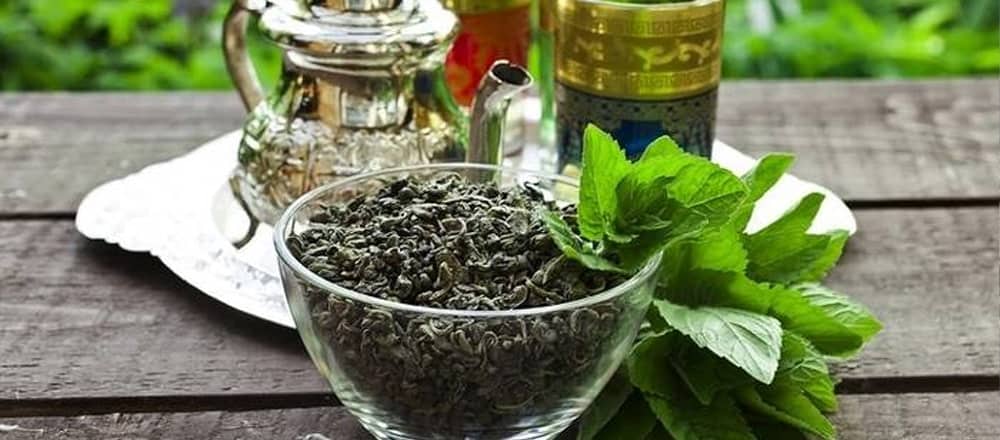
Moroccan Mint Tea Benefits
Four magic letters make all the difference when it comes to Moroccan Mint Tea Benefits: EGCG. You’ll be familiar with the term from the above table, which stands for “Epigallocatechin gallate”.
This is a polyphenolic catechin – better known as an antioxidant – capable of improving life in small yet significant ways. Primarily, it combats oxidative stress, thereby reducing the risk of numerous chronic conditions.
But that’s not all that it can do, nor is EGCG the only constituent doing it. This isn’t us making things up, either, as these health benefits have the backing of much of modern science.
We have compiled the facts and figures, all supported by verified research, below. All you need to do, then, is sit back and discover the wonders of Moroccan Mint Tea benefits.

Moroccan Mint Green Tea Weight Loss
There are several ways in which your morning cuppa can contribute to you dropping pounds. Perhaps the most obvious way is the fact that Moroccan Mint Tea calories have little influence over your waistline.
But then there are the ingredients themselves. One study published in the Journal of Research in Medical Science found that Green Tea, for instance, boosted the metabolism of fat cells.
Scientists concluded that each volunteer experienced a significant drop in body weight, their BMI, waist circumference and blood pressure following two months of consumption.
These participants – all of whom had type-2 diabetes – had, specifically, drunk four cups of Green Tea daily during this period. It appeared to be enough to promote weight loss.
The reason it worked was that boosting metabolism enabled the body to burn fat quicker and more efficiently, meaning that periods of exercise produced “better” results. And the Mint in Moroccan Mint Tea has a similar effect.
What’s more, a 2013 study published in Phytochemistry found that its menthol content served as an appetite suppressant – thus preventing you from overeating in the first place!
It’s worth remembering, though, that Moroccan Mint Green Tea weight loss benefits only apply when you put the extra work in. In other words, if you want to see “real” results, you’ll need to keep up those morning jogs and evening salads.
This Tea (or any Tea for that matter) should not be seen as a “fix-all” solution. It is instead an accompaniment to a healthy and active lifestyle.

Moroccan Mint Tea Acne
There is no single cure for acne, a skin condition that occurs when hair follicles become clogged with oil and dead skin cells. This often leads to a breakout in whiteheads, blackheads or pimples, which tend to appear on the face, forehead, chest, upper back and shoulders.
Despite most commonly affecting teenagers going through puberty, acne exists in people of all ages.
Can Morrocan Mint Tea for acne serve you well? Absolutely. For starters, the Gunpowder Green Tea leaves in it, according to a 2016 Swiss study, reduce sebum secretion. This not only helps to prevent significant acne breakouts but also stops oily skin.
Another study published in the Bosnian Journal of Medical Sciences found that Green Tea reduced acne after eight weeks of consumption.
Mint Tea, meanwhile, has anti-inflammatory properties that reduce the redness caused by acne. Additionally, its antiseptic qualities prevent the build-up of bacteria that clogs pores.
If you’d like to discover its potential for yourself, consider using Moroccan Mint Tea topically. However, it might first be worth speaking to a medical professional should you have any concerns.
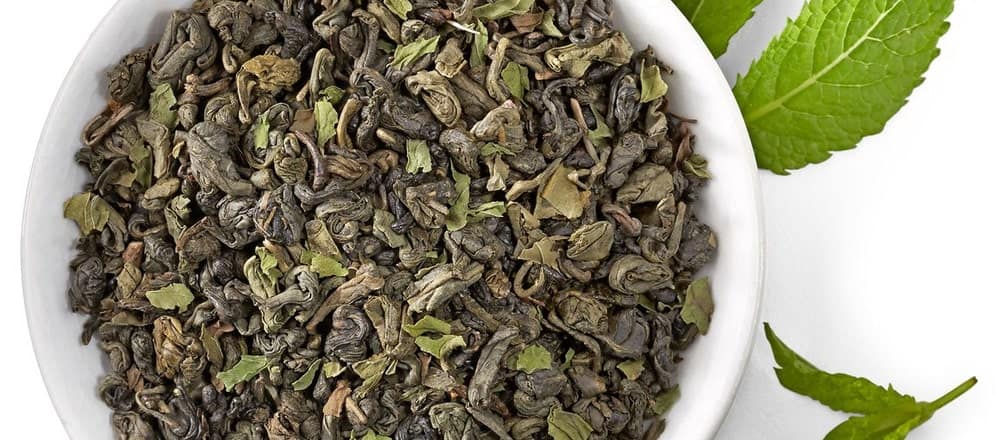
Moroccan Mint Tea Digestion
We have so far established that Moroccan Mint Tea weight loss benefits can help you to fit into your favourite pair of jeans again. Then there is the fact that a Moroccan Mint Tea acne treatment can keep your skin looking vibrant and youthful.
It’s now time to explore its influence on your gut health. We’ll start this time with mint, which can reduce indigestion, bloating, flatulence and other similar complaints.
Green Tea, too, can reduce bloating while at the same time preventing constipation. It also, like Peppermint Tea, has anti-inflammatory properties, which in this instance relieve some of the flare-ups associated with ulcerative colitis.
The answers come from a 56-day study where volunteers experienced improved ulcerative colitis symptoms by 58.3% compared to no improvements in a placebo group.

Moroccan Mint Tea Sleep
Would you believe that the benefits of drinking Moroccan Mint Tea extend to your bedtime routine? This is because it contains high levels of an amino acid called theanine, which improves sleeping patterns.
Theanine works with gamma-aminobutyric acid (GABA), a chemical compound that already exists in the body, to increase melatonin. In doing so, it helps to stabilise moods while regulating the wake-sleep cycle.
There is a downside to a Moroccan Mint Tea sleep routine, however, due to it containing caffeine. We’ll talk about this more further into this article.
In the meantime, you could think about Herbal Tea alternatives such as Camomile, Lavender or Rose Petals. (We actually stock a Camomile, Lavender and Rose Herbal Blend if such a mixture sounds appealing).
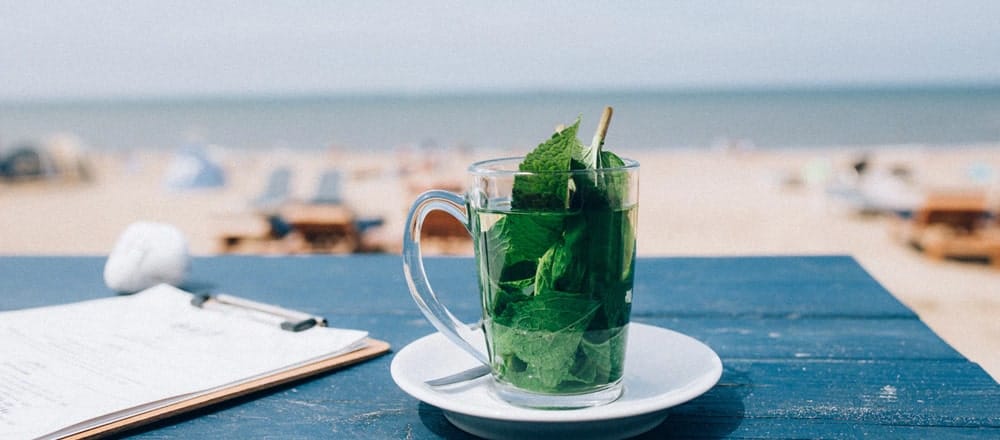
Moroccan Mint Tea Side Effects
Moroccan Mint Tea benefits have much to offer, including weight loss, healthier skin, fewer digestive complaints and a good night’s sleep.
We would love to say it’s all good news. However, and most unfortunately, we should probably cover Moroccan Mint Tea side effects. The following list shows the most reported concerns associated with this beverage:
- Restlessness and sleeplessness.
- Headaches.
- Irregular heartbeat and palpitations.
- Ringing in the ears.
- Nausea and vomiting.
- Diarrhoea or constipation.
It’s worth noting that the above side effects are nevertheless rare in almost all instances. Still, if you experience these issues or indeed have discomfort of any kind, you should consider seeking medical consultation.
The Kent and Sussex Tea and Coffee Company, first and foremost, care about the welfare of its customers. That’s why we’ll always advocate that you speak to the experts when required.
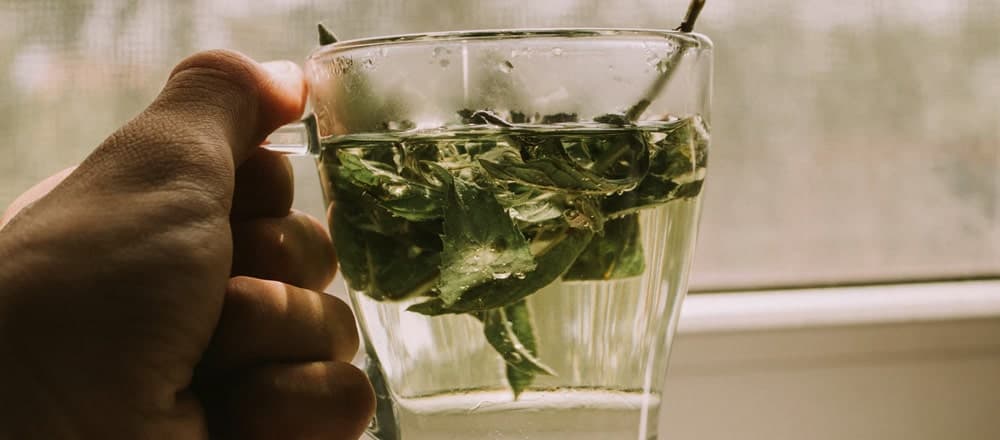
Is Moroccan Mint Tea Safe During Pregnancy?
There has been an ongoing debate on whether an expecting mother drinking Tea is a good idea. Many point to the fact that it contains caffeine, which might have a negative influence on pregnant women.
Additionally, according to a 2012 study, too much Tea can interfere with the absorption of folic acid, a factor that could lead to complications later down the line.
You’re probably wondering, then, “is Moroccan Mint Tea safe during pregnancy?” The answer is that it should be fine in moderation. NHS Choices states that those who’re pregnant should not exceed more than 200-mg of caffeine daily.
This is the equivalent of two cups of Coffee (depending on the type), four cups of Black Tea and six cups of Green Tea.

Moroccan Mint Tea Caffeine
Around 60 plants naturally contain caffeine, a stimulating chemical compound that, while risky to pregnant women, can undoubtedly get you out of bed in the morning.
Neither Peppermint (Mentha piperita) or Spearmint (Mentha spicata) are in this family of sixty. So-called “real” Tea (Camellia sinensis), however, and as we have already established, does belong to the group.
So long as your favourite beverage contains Green Tea leaves, then, it also has caffeine. But what is the Moroccan Mint Tea caffeine level? On average, an 8-oz cuppa of it has around 30-mg of this constituent.
The bottom line is it’s not going to have you jumping off the ceiling, but it will provide you with an energy boost.
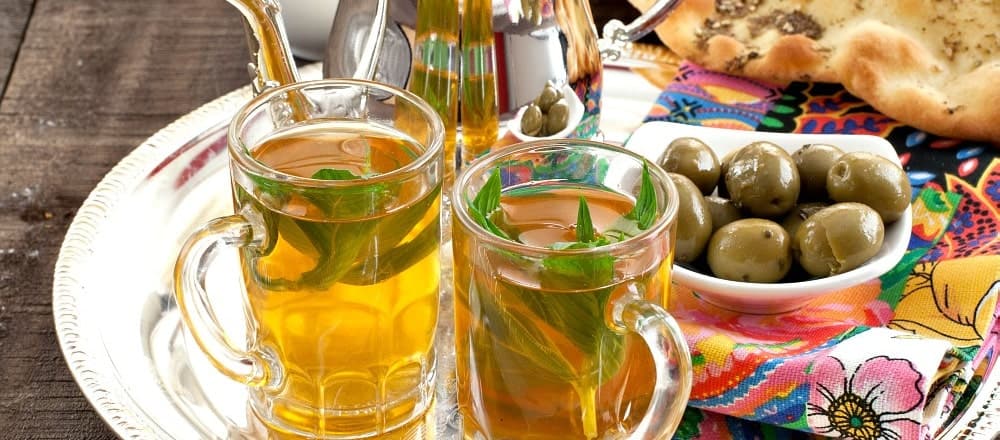
How to Make Moroccan Mint Tea
And there you have it: Moroccan Mint Tea benefits and side effects backed by irrefutable evidence.
Are you thirsty for more? We’d suggest you start brewing, then! If you’re asking yourself, “How do you make Moroccan Mint Tea?”, we have provided a step-by-step guide below. You’ll need either a Tea Infuser or Filter, but once you do, it won’t be long before you’re enjoying Moroccan Mint Tea benefits.
1, Use a Tea Filter / Infuser.
Put Loose Leaf Moroccan Mint Tea into a Tea Filter or Tea Infuser.
2, Boil Water in the Kettle.
Bring freshly boiled water to temperatures between 70°C and 90°C. Any hotter and you risk burning the leaves, which creates an unpleasantly bitter taste.
3, Add Filter or Infuser to your Mug.
Place the Tea-filled accessory into a mug or cup.
4, It’s Time to Pour the Water.
Now that the water has cooled to appropriate temperatures, you can start brewing.
5, Allow it to Steep.
Leave it to infuse for NO LONGER than three minutes. We recommend somewhere between one and two minutes to avoid overbrewing the Tea.
6, Enjoy Loose Moroccan Mint Tea.
All that’s left is to sit back, relax and embrace its grassy, minty flavours.
You could, of course, follow traditional Moroccan methods of making it if you have all of the items to hand. Alternatively, if you’re looking to pursue a Moroccan Mint Tea recipe from scratch, we stock Gunpowder Tea, Peppermint Tea and Spearmint Tea so you can mix to your specifications.
Whatever you decide, The Kent and Sussex Tea and Coffee Company has you covered.
Conclusion
Moroccan Mint Tea is the product of the North African country of the same name. Its cultural importance cannot be overstated. Whether you want to enjoy its role in local society or to experience Moroccan Mint Tea benefits, you’re in for a treat.
This beverage is a true delight to the senses – one that works as a Moroccan Mint Tea skin treatment while promoting weight loss. Why not try it today?

 Loose Leaf Tea
Loose Leaf Tea Pyramids
Pyramids Tea Bags
Tea Bags Africa
Africa Assam
Assam Ceylon
Ceylon Chinese
Chinese Darjeeling
Darjeeling European
European Indian
Indian Japan
Japan Nepal
Nepal South East Asia
South East Asia Ayurveda Tea
Ayurveda Tea Black Tea
Black Tea Chai Tea
Chai Tea Flowering Tea
Flowering Tea Fruit Tisanes
Fruit Tisanes Green Tea
Green Tea Herbal Tea
Herbal Tea Matcha Tea
Matcha Tea Oolong Tea
Oolong Tea Organic Tea
Organic Tea Pu erh Tea
Pu erh Tea Rooibos Tea
Rooibos Tea White Tea
White Tea Asian Coffee
Asian Coffee Caribbean Coffee
Caribbean Coffee Central American Coffee
Central American Coffee South American Coffee
South American Coffee Coffee Blends
Coffee Blends Decaffeinated Coffee
Decaffeinated Coffee Espresso Coffee
Espresso Coffee Ethically Sourced Coffee
Ethically Sourced Coffee Flavoured Coffee
Flavoured Coffee Organic Coffee
Organic Coffee Single Origin Coffee
Single Origin Coffee Chocolate 1
Chocolate 1 Chocolate 2
Chocolate 2 Chocolate 3
Chocolate 3 Chocolate 4
Chocolate 4 Chocolate 5
Chocolate 5 Chocolate 6
Chocolate 6 Chocolate 7
Chocolate 7 Chocolate 8
Chocolate 8 Chocolate 9
Chocolate 9 Loose Tea Filters
Loose Tea Filters Tea Accessories
Tea Accessories Tea Bricks
Tea Bricks Tea Caddies
Tea Caddies Tea Caddy Spoons
Tea Caddy Spoons Tea Gift Ideas
Tea Gift Ideas Tea Infusers
Tea Infusers Tea Strainers
Tea Strainers